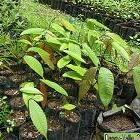A tall tree. It grows 35 m high. The bark is thick. When the bark is cut a nutritious milky sap flows out. The leaves are thick and leathery. They are 10-20 cm long and narrowly oval and taper to the tip. The fruit are made up of several fused together. There are one or two seeds.
obliquely affixed to the filament, obviously longitudinal in dehiscence. Fruit depressed-globose, 2.0-2.5 cm. in diameter.


